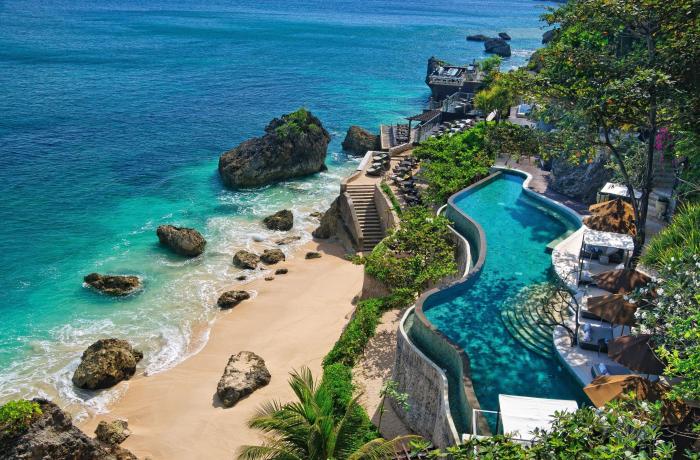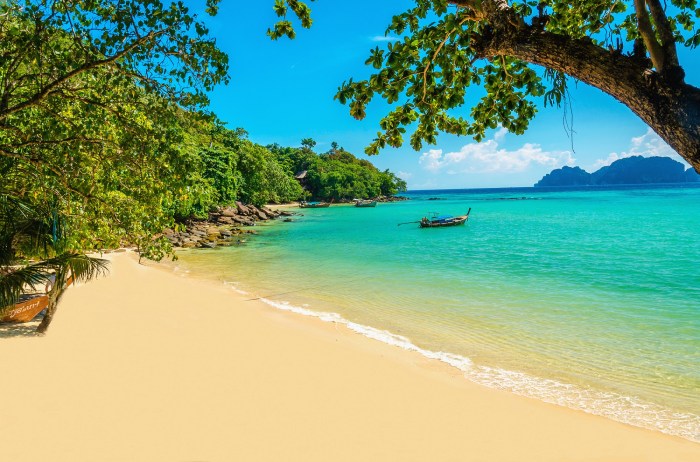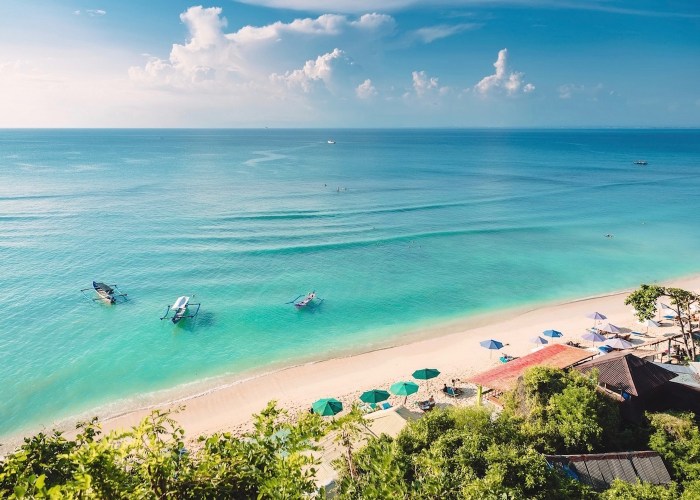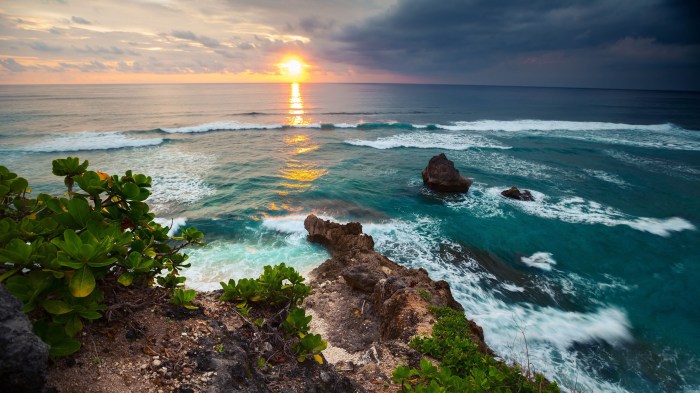The Bali Sea, a captivating expanse of water nestled between the islands of Java, Bali, and Lombok, beckons with its rich biodiversity, economic significance, and historical charm. This multifaceted sea holds a treasure trove of stories, from the vibrant marine life that calls it home to the thriving industries that rely on its resources.
From the depths of the Bali Sea to the bustling shores that line its perimeter, this Artikel delves into the fascinating world of this unique body of water, exploring its geographic features, physical characteristics, economic importance, environmental concerns, historical and cultural significance, and ongoing research and exploration efforts.
Geographic Overview

The Bali Sea is a marginal sea of the Pacific Ocean, located between the islands of Java and Bali in Indonesia. It is bordered by the Java Sea to the west, the Indian Ocean to the south, and the Flores Sea to the east.
The Bali Sea is approximately 200 kilometers long and 150 kilometers wide, with a total area of about 30,000 square kilometers.
Dimensions and Boundaries, Bali sea
| Dimension | Measurement |
|---|---|
| Length | 200 kilometers |
| Width | 150 kilometers |
| Area | 30,000 square kilometers |
Physical Characteristics

The Bali Sea is characterized by its shallow depth, high salinity, and warm temperatures. The average depth of the sea is around 70 meters (230 feet), with a maximum depth of 150 meters (490 feet) in the southern part. The salinity of the sea ranges from 32 to 34 parts per thousand, which is higher than the average salinity of the ocean.
The temperature of the sea is relatively constant throughout the year, with an average temperature of 28 degrees Celsius (82 degrees Fahrenheit).
Unique Marine Life and Ecosystems
The Bali Sea is home to a diverse range of marine life, including over 500 species of fish, 300 species of corals, and 600 species of mollusks. The sea is also home to several unique ecosystems, including coral reefs, seagrass beds, and mangrove forests.
Coral reefs are found throughout the sea, but are particularly common in the southern part. Seagrass beds are found in the shallow waters of the sea, and provide food and shelter for a variety of marine life. Mangrove forests are found along the coastlines of the sea, and help to protect the shoreline from erosion.
Visual Representation
The following table provides a summary of the physical characteristics of the Bali Sea:
| Characteristic | Value |
|---|---|
| Average depth | 70 meters (230 feet) |
| Maximum depth | 150 meters (490 feet) |
| Salinity | 32 to 34 parts per thousand |
| Temperature | 28 degrees Celsius (82 degrees Fahrenheit) |
Economic Importance

The Bali Sea holds immense economic significance, supporting various industries and livelihoods.
The Bali Sea, an arm of the Pacific Ocean, is known for its pristine waters and diverse marine life. Its calm currents and sheltered coves make it an ideal destination for snorkeling and diving enthusiasts. Beyond the azure waters of the Bali Sea lies Penny Lane , a charming street in Liverpool, immortalized in the Beatles’ iconic song.
This quaint lane evokes a sense of nostalgia and reminds us of the enduring legacy of the band’s music. As we return to the tranquil waters of the Bali Sea, we can’t help but hum the melody of “Penny Lane,” its lyrics echoing through the serene surroundings.
The fishing industry plays a pivotal role in the local economy. The sea’s rich marine biodiversity provides a substantial source of income for many coastal communities.
Fishing Industry
- Abundant fish species, such as tuna, mackerel, and snapper, are harvested for commercial and subsistence purposes.
- Fishing techniques include traditional methods like line fishing and gillnetting, as well as modern techniques like trawling.
- The fishing industry provides employment opportunities and contributes significantly to the local food supply.
Tourism and recreation also contribute to the economic development of the Bali Sea region.
Tourism and Recreation
- The sea’s pristine waters, beautiful beaches, and vibrant marine life attract numerous tourists.
- Water sports such as diving, snorkeling, and surfing are popular activities.
- Tourism generates revenue through accommodation, dining, and transportation services.
Other industries that rely on the Bali Sea’s resources include:
Other Industries
- Marine aquaculture:Farming of fish and shellfish for commercial purposes.
- Salt production:Evaporation of seawater to produce salt, an essential commodity.
- Shipping:The sea serves as a vital shipping route for goods and transportation.
Environmental Concerns

The Bali Sea faces several environmental threats that pose risks to its ecosystem. These include pollution, overfishing, and climate change.
Pollution from various sources, including industrial effluents, agricultural runoff, and plastic waste, poses a significant threat to the Bali Sea. Overfishing, particularly of commercially valuable species such as tuna and snapper, has depleted fish stocks and disrupted the marine food web.
Climate Change
Climate change is another major concern for the Bali Sea. Rising sea levels due to climate change threaten coastal communities and infrastructure. Additionally, changes in ocean temperature and acidity can harm marine life and coral reefs.
The Bali Sea is a marginal sea located between Java and Bali in Indonesia. Central Jakarta is the central business district of Jakarta, Indonesia. It is home to many skyscrapers, shopping malls, and restaurants. The Bali Sea is a popular tourist destination, with many people coming to enjoy the beautiful beaches and clear waters.
Several conservation efforts and initiatives are underway to protect the Bali Sea’s biodiversity. These include:
- Establishment of marine protected areas to provide refuge for marine life.
- Implementation of sustainable fishing practices to reduce overfishing.
- Reduction of plastic waste and other pollutants entering the sea.
- Monitoring and research to assess the health of the Bali Sea and identify emerging threats.
Key Environmental Issues and Their Potential Impact
The following table summarizes the key environmental issues facing the Bali Sea and their potential impact:
| Environmental Issue | Potential Impact |
|---|---|
| Pollution | Degradation of water quality, harm to marine life, disruption of food webs |
| Overfishing | Depletion of fish stocks, disruption of marine food web, loss of livelihoods |
| Climate Change | Sea level rise, changes in ocean temperature and acidity, harm to marine life and coral reefs |
Historical and Cultural Significance
The Bali Sea holds historical and cultural significance for local communities. Historically, it served as a vital trade route connecting Southeast Asia to the Indian Ocean. Traders from India, China, and the Middle East sailed through the Bali Sea, carrying spices, textiles, and other goods.
The sea also played a role in the spread of Hinduism and Buddhism to the Indonesian archipelago.Culturally, the Bali Sea is considered sacred by local communities. It is believed to be the abode of the sea goddess Dewi Danu, who is worshipped by the Balinese people.
The sea is also associated with various traditional ceremonies and rituals, such as the Melasti ceremony, where offerings are made to the sea to purify it before Nyepi, the Balinese New Year.
The Bali Sea is a marginal sea of the Pacific Ocean that separates the islands of Java and Bali. The Ngurah Rai International Airport DPS is the main international airport on the island of Bali, located in the southern part of the island.
The airport is named after I Gusti Ngurah Rai, a Balinese national hero who fought against the Dutch during the Indonesian National Revolution. The Bali Sea is a popular destination for tourists, who come to enjoy the beautiful beaches, coral reefs, and marine life.
Historical Timeline
- Pre-Hindu Period:The Bali Sea was a major trade route for the indigenous Austronesian peoples.
- Hindu-Buddhist Period (8th-15th centuries):The sea played a significant role in the spread of Hinduism and Buddhism to the Indonesian archipelago.
- European Exploration (16th-19th centuries):Portuguese, Dutch, and British explorers sailed through the Bali Sea, establishing trading posts and competing for control of the region.
- Independence Period (20th century):After Indonesia gained independence, the Bali Sea became an important economic zone for fishing and tourism.
Cultural Practices
- Melasti Ceremony:A purification ritual held before Nyepi, where offerings are made to the sea goddess Dewi Danu.
- Sea Temple (Tanah Lot):A famous Hindu temple built on a rock formation in the sea, dedicated to the sea gods.
- Traditional Fishing:Local communities have traditionally relied on the Bali Sea for fishing, using traditional methods such as jukung boats and bamboo traps.
Research and Exploration: Bali Sea

The Bali Sea has been the subject of ongoing scientific research and exploration efforts, contributing to our understanding of its unique environment and ecosystem.
Researchers have conducted studies on various aspects of the Bali Sea, including its physical characteristics, biodiversity, and environmental dynamics. These efforts have yielded valuable insights into the functioning of the ecosystem and the challenges it faces.
Notable Research Projects
- Bali Sea Biodiversity Survey:A comprehensive survey conducted in 2015 documented over 1,500 marine species in the Bali Sea, including new discoveries and range extensions.
- Oceanographic Studies:Researchers have investigated the ocean currents, water quality, and temperature profiles of the Bali Sea, providing insights into its physical dynamics and ecosystem processes.
- Coral Reef Monitoring:Ongoing monitoring programs track the health and resilience of coral reefs in the Bali Sea, assessing the impacts of human activities and climate change.
- Marine Conservation Initiatives:Research efforts have supported the development and implementation of marine protected areas and conservation strategies to protect the biodiversity and ecosystem integrity of the Bali Sea.
Final Wrap-Up

As we conclude our exploration of the Bali Sea, we are left with a profound appreciation for its multifaceted nature. It is a sea that sustains livelihoods, captivates the imagination, and holds the key to unlocking further scientific discoveries. The Bali Sea stands as a testament to the delicate balance between human activity and the natural world, reminding us of the importance of conservation and sustainable practices to preserve this precious marine ecosystem for generations to come.
FAQ Guide
What is the approximate depth of the Bali Sea?
The average depth of the Bali Sea is around 150 meters (492 feet).
What are some of the key industries that rely on the Bali Sea?
Fishing, tourism, and recreation are the primary industries that depend on the Bali Sea’s resources.
What are the main environmental threats facing the Bali Sea?
Pollution, overfishing, and climate change pose significant threats to the Bali Sea’s ecosystem.